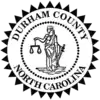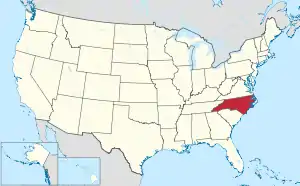Durham County | |
|---|---|
 | |
 Flag  Seal  Logo | |
| Motto: "Live. Grow. Thrive." | |
 Location within the U.S. state of North Carolina | |
 North Carolina's location within the U.S. | |
| Coordinates: 36°02′02″N 78°52′41″W / 36.033828°N 78.878125°W | |
| Country | |
| State | |
| Founded | 1881 |
| Named for | Bartlett Snipes Durham |
| Seat | Durham |
| Largest community | Durham |
| Area | |
| • Total | 297.86 sq mi (771.5 km2) |
| • Land | 286.53 sq mi (742.1 km2) |
| • Water | 11.33 sq mi (29.3 km2) 3.80% |
| Population (2020) | |
| • Total | 324,833 |
| • Estimate (2022) | 332,680 |
| • Density | 1,133.68/sq mi (437.72/km2) |
| Time zone | UTC−5 (Eastern) |
| • Summer (DST) | UTC−4 (EDT) |
| Congressional district | 4th |
| Website | www |
Durham County is a county located in the U.S. state of North Carolina. As of the 2020 census, the population was 324,833,[1] making it the sixth-most populous county in North Carolina. Its county seat is Durham,[2] which is the only incorporated municipality predominantly in the county, though very small portions of cities and towns mostly in neighboring counties also extend into Durham County. The central and southern parts of Durham County are highly urban, consisting of the city as well as several unincorporated suburbs. Southeastern Durham County is dominated by the Research Triangle Park, most of which is in Durham County. The northern third of Durham County is rural in nature.
Durham County is the core of the Durham-Chapel Hill, NC Metropolitan Statistical Area, which is also included in the Raleigh-Durham-Cary, NC Combined Statistical Area, which had a population of 2,106,463 in 2020.[3]
History
The county was formed on April 17, 1881, from parts of Orange County and Wake County, taking the name of its own county seat. In 1911, parts of Cedar Fork Township of Wake County were transferred to Durham County and became Carr Township.
Geography
According to the U.S. Census Bureau, the county has a total area of 297.86 square miles (771.5 km2), of which 286.53 square miles (742.1 km2) is land and 11.33 square miles (29.3 km2) (3.80%) is water.[4]
State and local protected areas/sites
- Bennett Place State Historic Site
- Butner-Falls of Neuse Game Land (part)[5]
- Duke Homestead and Tobacco Factory
- East Durham Historic District
- Eno River State Park (part)
- Falls Lake State Recreation Area (part)
- Historic Stagville
- Hollow Rock Nature Park (part)[6]
- Horton Grove Nature Preserve[7]
- Jordan Game Land (part)[5]
- Little River Regional Park and Natural Area (part)[8]
- Mason Farm Biological Reserve (part)[9]
- Museum of Life and Science
- Rolling View State Recreation Area (part)[10]
Major water bodies
Adjacent counties
- Person County – north
- Granville County – northeast
- Wake County – east-southeast
- Chatham County – south
- Orange County – west
Major highways
 I-40
I-40 I-85
I-85

 I-540 / NC 540 Toll
I-540 / NC 540 Toll

 I-885 / NC 885 Toll
I-885 / NC 885 Toll US 15
US 15
 US 15 Bus.
US 15 Bus. US 70
US 70
 US 70 Bus. (Durham)
US 70 Bus. (Durham)
 US 70 Bus. (to Orange County)
US 70 Bus. (to Orange County) US 501
US 501 NC 54
NC 54 NC 55
NC 55 NC 98
NC 98 NC 147
NC 147 NC 157
NC 157 NC 751
NC 751
 NC 751 Truck (truck route)
NC 751 Truck (truck route)
Major infrastructure
Demographics
| Census | Pop. | Note | %± |
|---|---|---|---|
| 1890 | 18,041 | — | |
| 1900 | 26,233 | 45.4% | |
| 1910 | 35,276 | 34.5% | |
| 1920 | 42,219 | 19.7% | |
| 1930 | 67,196 | 59.2% | |
| 1940 | 80,244 | 19.4% | |
| 1950 | 101,639 | 26.7% | |
| 1960 | 111,995 | 10.2% | |
| 1970 | 132,681 | 18.5% | |
| 1980 | 152,785 | 15.2% | |
| 1990 | 181,835 | 19.0% | |
| 2000 | 223,314 | 22.8% | |
| 2010 | 267,587 | 19.8% | |
| 2020 | 324,833 | 21.4% | |
| 2022 (est.) | 332,680 | [1] | 2.4% |
| U.S. Decennial Census[11] 1790–1960[12] 1900–1990[13] 1990–2000[14] 2010–2020[1] | |||
2020 census
| Race | Number | Percentage |
|---|---|---|
| White (non-Hispanic) | 133,768 | 41.18% |
| Black or African American (non-Hispanic) | 109,225 | 33.62% |
| Native American | 704 | 0.22% |
| Asian | 16,707 | 5.14% |
| Pacific Islander | 83 | 0.03% |
| Other/Mixed | 14,242 | 4.38% |
| Hispanic or Latino | 50,104 | 15.42% |
As of the 2020 census, there were 324,833 people, 131,140 households, and 75,291 families residing in the county.
2000 census
At the 2000 census,[16] there were 223,314 people, 89,015 households, and 54,032 families residing in the county. The population density was 769 people per square mile (297 people/km2). There were 95,452 housing units at an average density of 329 units per square mile (127 units/km2). The racial makeup of the county was 50.91% White, 39.46% Black or African American, 0.30% Native American, 3.29% Asian, 0.04% Pacific Islander, 4.21% from other races, and 1.80% from two or more races. 7.63% of the population were Hispanic or Latino of any race.
There were 89,015 households, out of which 29.10% had children under the age of 18 living with them, 42.00% were married couples living together, 14.80% had a female householder with no husband present, and 39.30% were non-families. 30.00% of all households were made up of individuals, and 7.00% had someone living alone who was 65 years of age or older. The average household size was 2.40 and the average family size was 2.99.
In the county, the age distribution was as follows: 22.90% under the age of 18, 12.80% from 18 to 24, 34.80% from 25 to 44, 19.80% from 45 to 64, and 9.70% who were 65 years of age or older. The median age was 32 years. For every 100 females there were 93.00 males. For every 100 females age 18 and over, there were 89.70 males.
The median income for a household in the county was $43,337, and the median income for a family was $53,223. Males had a median income of $35,939 versus $30,683 for females. The per capita income for the county was $23,156. About 9.80% of families and 13.40% of the population were below the poverty line, including 17.20% of those under age 18 and 12.30% of those age 65 or over.
Law and government
| Durham County Sheriff's Office | |
|---|---|
| Abbreviation | DCSO, DSO |
| Motto | "Honor, Duty and Service." |
| Agency overview | |
| Formed | May 2, 1881 |
| Employees | 452 |
| Annual budget | $34,949,195 |
| Jurisdictional structure | |
| Operations jurisdiction | Durham County, North Carolina, US |
| General nature | |
| Operational structure | |
| Headquarters | 510 S Dillard St, Durham |
| Sworn officers | |
| Civilians | 59[17] |
| Agency executive |
|
| Facilities | |
| Sub-Stations | 2 |
| Notables | |
| Award | |
| Website | |
| Official website | |
Durham County is a member of the regional Triangle J Council of Governments. Durham County is governed by a five-member board of county commissioners, currently consisting of Chair Brenda A. Howerton, Vice Chair Wendy Jacobs, Nimasheena Burns, Heidi Carter, and Nida Allam.[18] All are elected concurrently, and each elected member serves a four-year term. The current sheriff, Clarence Birkhead, was elected in 2018 and is the county's first African American Sheriff to hold office.[19]
Politics
Durham County is consistently one of the most Democratic counties in North Carolina, favoring Democrats in national, state, and local elections.[20] having only voted for the Republican candidate twice since 1884, the Republican landslides of 1928 and 1972. George H. W. Bush is the last Republican to manage even 40 percent of the county's vote. Since the 1990s, Durham County has been one of the most Democratic urban counties in the South.
| Year | Republican | Democratic | Third party | |||
|---|---|---|---|---|---|---|
| No. | % | No. | % | No. | % | |
| 2020 | 32,459 | 18.04% | 144,688 | 80.42% | 2,767 | 1.54% |
| 2016 | 28,350 | 18.16% | 121,250 | 77.66% | 6,534 | 4.18% |
| 2012 | 33,769 | 23.01% | 111,224 | 75.80% | 1,742 | 1.19% |
| 2008 | 32,353 | 23.63% | 103,456 | 75.57% | 1,088 | 0.79% |
| 2004 | 34,614 | 31.57% | 74,524 | 67.96% | 513 | 0.47% |
| 2000 | 30,150 | 35.64% | 53,907 | 63.72% | 547 | 0.65% |
| 1996 | 27,825 | 34.39% | 49,186 | 60.79% | 3,899 | 4.82% |
| 1992 | 27,581 | 33.36% | 47,331 | 57.24% | 7,770 | 9.40% |
| 1988 | 29,928 | 45.43% | 35,441 | 53.79% | 514 | 0.78% |
| 1984 | 29,185 | 47.39% | 32,244 | 52.36% | 155 | 0.25% |
| 1980 | 19,276 | 40.24% | 24,969 | 52.13% | 3,656 | 7.63% |
| 1976 | 18,945 | 45.61% | 22,425 | 53.99% | 163 | 0.39% |
| 1972 | 25,576 | 61.38% | 15,566 | 37.36% | 525 | 1.26% |
| 1968 | 12,705 | 29.68% | 16,563 | 38.69% | 13,542 | 31.63% |
| 1964 | 15,264 | 40.02% | 22,874 | 59.98% | 0 | 0.00% |
| 1960 | 14,322 | 42.60% | 19,298 | 57.40% | 0 | 0.00% |
| 1956 | 13,226 | 48.87% | 13,835 | 51.13% | 0 | 0.00% |
| 1952 | 11,301 | 37.42% | 18,897 | 62.58% | 0 | 0.00% |
| 1948 | 4,531 | 25.73% | 11,530 | 65.46% | 1,552 | 8.81% |
| 1944 | 3,690 | 22.43% | 12,763 | 77.57% | 0 | 0.00% |
| 1940 | 2,491 | 14.40% | 14,810 | 85.60% | 0 | 0.00% |
| 1936 | 2,189 | 14.60% | 12,804 | 85.40% | 0 | 0.00% |
| 1932 | 2,770 | 25.94% | 7,559 | 70.78% | 351 | 3.29% |
| 1928 | 8,723 | 66.06% | 4,482 | 33.94% | 0 | 0.00% |
| 1924 | 3,093 | 37.95% | 4,837 | 59.34% | 221 | 2.71% |
| 1920 | 3,550 | 43.31% | 4,646 | 56.69% | 0 | 0.00% |
| 1916 | 1,837 | 42.72% | 2,463 | 57.28% | 0 | 0.00% |
| 1912 | 124 | 3.52% | 2,197 | 62.31% | 1,205 | 34.17% |
| 1908 | 1,820 | 49.35% | 1,859 | 50.41% | 9 | 0.24% |
| 1904 | 1,080 | 40.10% | 1,603 | 59.52% | 10 | 0.37% |
| 1900 | 2,026 | 45.86% | 2,373 | 53.71% | 19 | 0.43% |
| 1896 | 1,924 | 43.62% | 2,435 | 55.20% | 52 | 1.18% |
| 1892 | 1,264 | 35.93% | 1,490 | 42.35% | 764 | 21.72% |
| 1888 | 1,618 | 45.77% | 1,835 | 51.91% | 82 | 2.32% |
| 1884 | 1,193 | 42.79% | 1,595 | 57.21% | 0 | 0.00% |
Communities

The city of Durham is the only incorporated municipality to predominantly exist within Durham County, and the only one whose urban core lies within the county, though small portions of municipalities from neighboring counties extend into Durham County, and the city of Durham also itself extends slightly into neighboring counties. All other towns and places within Durham County are unincorporated communities.
Cities
Towns
- Chapel Hill (mostly in Orange County)
- Morrisville (mostly in Wake County)
Townships
Census-designated places
Unincorporated communities
Notable person
- Margaret O'Neal (1884–?), sharecropper[23]
See also
- List of counties in North Carolina
- National Register of Historic Places listings in Durham County, North Carolina
- Research Triangle Park, largest Research park in the United States
- Bull Durham, 1988 romantic comedy about the Durham Bulls
References
- 1 2 3 "QuickFacts: Durham County, North Carolina". United States Census Bureau. Retrieved May 31, 2022.
- ↑ "Find a County". National Association of Counties. Archived from the original on July 12, 2012. Retrieved June 7, 2011.
- ↑ "County Population Totals and Components of Change: 2010-2020". United States Census Bureau. Retrieved May 25, 2021.
- ↑ "2020 County Gazetteer Files – North Carolina". United States Census Bureau. August 23, 2022. Retrieved September 9, 2023.
- 1 2 "NCWRC Game Lands". www.ncpaws.org. Retrieved March 30, 2023.
- ↑ "Hollow Rock Nature Park". Orange County, NC. Retrieved July 27, 2022.
- ↑ "Miles of Trails with More in the Making - Triangle Land Conservancy". www.triangleland.org. December 11, 2015. Retrieved July 27, 2022.
- ↑ "Little River Regional Park & Natural Area". Eno River Association - Education, Advocacy & Conservation. Retrieved July 27, 2022.
- ↑ "Mason Farm Biological Reserve - North Carolina Botanical Garden". Retrieved July 27, 2022.
- ↑ "Rollingview at Falls Lake Durham, NC". www.visitnc.com. Retrieved July 27, 2022.
- ↑ "U.S. Decennial Census". United States Census Bureau. Archived from the original on July 1, 2021. Retrieved January 14, 2015.
- ↑ "Historical Census Browser". University of Virginia Library. Archived from the original on August 11, 2012. Retrieved January 14, 2015.
- ↑ Forstall, Richard L., ed. (March 27, 1995). "Population of Counties by Decennial Census: 1900 to 1990". United States Census Bureau. Archived from the original on March 3, 2015. Retrieved January 14, 2015.
- ↑ "Census 2000 PHC-T-4. Ranking Tables for Counties: 1990 and 2000" (PDF). United States Census Bureau. April 2, 2001. Archived (PDF) from the original on December 18, 2014. Retrieved January 14, 2015.
- ↑ "Explore Census Data". data.census.gov. Archived from the original on April 12, 2022. Retrieved December 20, 2021.
- ↑ "U.S. Census website". United States Census Bureau. Archived from the original on July 9, 2021. Retrieved January 31, 2008.
- 1 2 3 "Annual Report FY 2016-2017". Durham Sheriff. 2017. Archived from the original on January 8, 2020. Retrieved April 12, 2022.
- ↑ "Contact the Board of Commissioners | Durham County". www.dconc.gov. Archived from the original on March 28, 2022. Retrieved April 12, 2022.
- ↑ Simmons, Taj (December 3, 2018). "New Durham County Sheriff Takes Oath of Office". spectrumlocalnews.com. Archived from the original on April 19, 2019. Retrieved April 12, 2022.
- ↑ "Anatomy of a swing state: What these 6 counties tell us about the upcoming NC election". The Charlotte Observer. November 4, 2022. Retrieved November 4, 2022.
- ↑ Leip, David. "Dave Leip's Atlas of U.S. Presidential Elections". uselectionatlas.org. Archived from the original on March 23, 2018. Retrieved March 15, 2018.
- ↑ Raleigh Durham Annexation Agreement Lines Archived October 19, 2011, at the Wayback Machine
- ↑ "Federal Writers Project Papers".
External links
 Geographic data related to Durham County, North Carolina at OpenStreetMap
Geographic data related to Durham County, North Carolina at OpenStreetMap- Official website
- Greater Durham Chamber of Commerce
- Durham County Library website
- North Carolina Room of the Durham County Library, online archive which collects materials concerning the city and county of Durham

